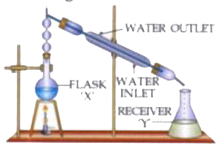Consider the bromination of butane using sufficient bromine to cause dibromination. After these reaction is over, you separate all the dibromobutane isomers by gas chromatography or by fractional distillation. How many fractions would you obtain, and what compounds would the individual fractions contain? Which if any of the fractions would be optically active?
The construction of handheld models will help in solving this problem. First, decide how many constitutional isomers are possible by replacing two hydrogens of butane with two bromine atoms. There are six: 1, 1-dibromobutane, 1, 2-dibromobutane, 2, 2-dibromobutane, 2, 3-dibromobutane, 1, 3-dibromobutane, and 1, 4-dibromobutane. Then recall that constitutional isomers have different physical properties (i.e., boiling points and retention times in a gas chromatograph), so there should be at least six fractions. In actuality there are seven. See fractions (a)-(g) below. We soon see why there are seven fractions if we examine each constitutional isomer looking for chirality centers and stereoisomers. Isomers (a), (c ) and (g) have no chirality centers and are, therefore, achiral and are optically inactive. 1, 2-Dibromobutane in fraction (b) and 1, 4-dibromobutane in fraction (f ) each have one chirality center and, because there is no chiral influence on the reaction, they will be formed as a 50:50 mixture of enantiomers (a racemate). A racemate cannot be separated by distillation or conventional gas chromatography, there fore, fractions (b) and (f ) will not be optically active. 2, 3-Dibromobutane has two chirality centers and will be formed as a racemate [fraction (d)] and as a meso compound, fraction (e ). Both fractions will be optically inactive. The meso compound is a diastereomer of the enantiomers in fraction (d) (and has different physical properties from them), therefore, it is separated from them by distillation or gas chromatography.

Topper's Solved these Questions
- BOOK - MS CHOUHANCHAPTER - RADICAL REACTIONSEXERCISE - Practice Problem2videos
RADICAL REACTIONS
- BOOK - MS CHOUHANCHAPTER - RADICAL REACTIONSEXERCISE - Additional Objective Questions (Single Correct Choice Type)22videos
RADICAL REACTIONS
- BOOK - MS CHOUHANCHAPTER - PRACTICAL ORGANIC CHEMISTRYEXERCISE - Level 25videos
PRACTICAL ORGANIC CHEMISTRY
- BOOK - MS CHOUHANCHAPTER - REACTION OF AROMATIC COMPOUNDS EXERCISE - ADDITIONAL OBJECTIVE QUESTIONS (MULTIPLE CORRECT CHOICE TYPE)2videos
REACTION OF AROMATIC COMPOUNDS
Similar Questions
There are four dimethylcyclopropane isomers.
a. Write the three-dimensional formulas for these isomers.
b. Which of these isomers is chiral?
c. If a mixtrue consisting of 1mol of each of these isomers is subjected to simple gas chromatography, how many fractions would be obtained and how many compounds each fraction will have?
d. How many of these fractions would be optically active?View SolutionThere are four dimethylcyclopropane isomers.
a. Write the three-dimensional formulas for these isomers.
b. Which of these isomers is chiral?
c. If a mixtrue consisting of 1mol of each of these isomers is subjected to simple gas chromatography, how many fractions would be obtained and how many compounds each fraction will have?
d. How many of these fractions would be optically active?View Solution
Knowledge Check
- Question 1 - Select One
Take a living tissue, grind it in trichloroacetic acid using pestle and mortar, and then strain it, you would obtain two fractions : acid-soluble and acid-insoluble fraction. Acid-insoluble fraction does not contain
ApolysaccharidesBnucleic acidsClipidsDflavonoids and alkaloids. - Question 2 - Select One
Take a living tissue, grind it in trichloroacetic acid using pestle and mortal, and then strain it, you would obtain two fractions : acid-soluble and acid-insoluble fraction. Acid-insoluble fraction does not contain
ApolysaccharidesBnucleic acidsClipidsDflavonoids and alkaloids. - Question 3 - Select One
Isopentane is allowed to undergo free-radical chlorination and the reaction mixture is separated. How many optically active fractions of formula C5H11CI would you expect to collect?
AZeroBTwoCOneDFour
How many fractions can be obtained after fractional distillation of all dibromo derivatives of n-butane?
View SolutionWhy is it not possible to obtain pure ethanol by fractional distillation ? What general name is given to binary mixture which show deviation from Raoult's law and whose omponents cannot be separted by fractional distillation. How many types of such mixture are there?
View SolutionThe diagram represents fractional distillation for separation of mixtures. Answer the following: If methyl alcohol & water are to be separated, which liquid would remain in flask 'X' after condensation.
 View Solution
View SolutionA solution contain three stereo-isomers of 2, 3-dihydroxy butanedioic acid. On fractional crystallisation of this solution, two fractions: Fraction-1 and Fraction-II are separated. Fraction-I on reaction with (+)-2-butanamine gives a single salt while fraction-II on reaction with the same (+)-2-butanamine gives a mixture of two salts. answer the following three question based on the above information
(a) Molecules of fraction-I are enantiomers
(b) Molecules of fraction-I are meso compound
(c) Molecules of fraction-I are in racemic form
(d) Molecules of fraction-I has no chiral centre
What is the relationship between the two different salts obtained from fraction-II?View SolutionCompound which rotates the plane polarised light is known as optically active compound . On the basis of direction of rotation two forms of an optically active compounds are termed as dextro and laevo rotatory . The two are termed as enantiomers . If we have a 1 : 1 mixture of d and l isomers of a given chiral compound , optical rotation of such mixture is zero Such a mixture is optically inactive and is called a recemic modification.
The net specific rotation of any mixture of the d and isomers of a given chiral compound is equal to the weighted average of the rotations due to both the isomers Mathematically if can be expressed as :
[α]≠t=fd[αd]+f1[αl]
Where fa and fl are fractions of d and l isomers respectively and [αd],[αl] are their specific rotations
What is the enantiomeric excess in any pure sample of an optically active substance ?View Solution

